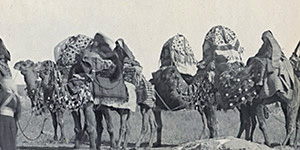
Weddings are one of the most important individual, family, and community events in Central Asian society. The occasion is marked in different ways, but kurak (patchwork) is a common element to many groups’ celebrations.
The Turkmen bride was traditionally carried to the home of her future husband perched high atop a camel in a palanquin (kejebe) elaborately decorated with patches, strips of cloth, and auspicious symbols draped over a domed framework of slender branches bent diagonally from corner to corner, representing a trellis tent (yurt), the traditional Turkmen dwelling. A grand procession of family members on richly outfitted camels followed. Among the Yomut tribes in the Akhal and Balkan regions, there were three types of kejebe: one to carry the bride (dik kejebe); one for the relatives, companions, and dowry (yan kejebe); and one in the shape of a heart (yürek kejebe).
In addition, Turkmen used a special, often large covering for the neck and head of the camel. This main trapping (düýe başlyq) was constructed of felted wool, broadcloth, and occasionally ikat. A network of talismanic diamond patches connected only at their points formed a lattice-like pattern called tor köz (network). Lacking such a cover, they substituted a patchwork quilt. According to Galina Artykova, senior ethnographer at the National Museum of Turkmenistan, the düýe başlyq was hung in the place of honor at the rear of the wedding tent (tör) and remained in the possession of the younger son of the husband’s family after the festivities until needed by the next family member.